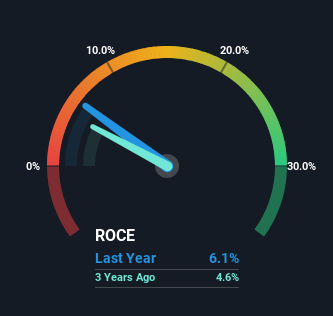
When we're researching a company, it's sometimes hard to find the warning signs, but there are some financial metrics that can help spot trouble early. A business that's potentially in decline often shows two trends, a return on capital employed (ROCE) that's declining, and a base of capital employed that's also declining. This reveals that the company isn't compounding shareholder wealth because returns are falling and its net asset base is shrinking. Having said that, after a brief look, Jiangsu Innovative Ecological New Materials (HKG:2116) we aren't filled with optimism, but let's investigate further.
Understanding Return On Capital Employed (ROCE)
For those who don't know, ROCE is a measure of a company's yearly pre-tax profit (its return), relative to the capital employed in the business. Analysts use this formula to calculate it for Jiangsu Innovative Ecological New Materials:
Return on Capital Employed = Earnings Before Interest and Tax (EBIT) ÷ (Total Assets - Current Liabilities)
0.061 = CN¥14m ÷ (CN¥246m - CN¥18m) (Based on the trailing twelve months to June 2024).
Therefore, Jiangsu Innovative Ecological New Materials has an ROCE of 6.1%. On its own that's a low return on capital but it's in line with the industry's average returns of 6.0%.
See our latest analysis for Jiangsu Innovative Ecological New Materials

While the past is not representative of the future, it can be helpful to know how a company has performed historically, which is why we have this chart above. If you'd like to look at how Jiangsu Innovative Ecological New Materials has performed in the past in other metrics, you can view this free graph of Jiangsu Innovative Ecological New Materials' past earnings, revenue and cash flow.
What Does the ROCE Trend For Jiangsu Innovative Ecological New Materials Tell Us?
In terms of Jiangsu Innovative Ecological New Materials' historical ROCE movements, the trend doesn't inspire confidence. Unfortunately the returns on capital have diminished from the 11% that they were earning five years ago. On top of that, it's worth noting that the amount of capital employed within the business has remained relatively steady. This combination can be indicative of a mature business that still has areas to deploy capital, but the returns received aren't as high due potentially to new competition or smaller margins. So because these trends aren't typically conducive to creating a multi-bagger, we wouldn't hold our breath on Jiangsu Innovative Ecological New Materials becoming one if things continue as they have.
The Bottom Line
In the end, the trend of lower returns on the same amount of capital isn't typically an indication that we're looking at a growth stock. The market must be rosy on the stock's future because even though the underlying trends aren't too encouraging, the stock has soared 267%. Regardless, we don't feel too comfortable with the fundamentals so we'd be steering clear of this stock for now.
Jiangsu Innovative Ecological New Materials does have some risks, we noticed 3 warning signs (and 1 which is a bit unpleasant) we think you should know about.
For those who like to invest in solid companies, check out this free list of companies with solid balance sheets and high returns on equity.
Have feedback on this article? Concerned about the content? Get in touch with us directly. Alternatively, email editorial-team (at) simplywallst.com.
This article by Simply Wall St is general in nature. We provide commentary based on historical data and analyst forecasts only using an unbiased methodology and our articles are not intended to be financial advice. It does not constitute a recommendation to buy or sell any stock, and does not take account of your objectives, or your financial situation. We aim to bring you long-term focused analysis driven by fundamental data. Note that our analysis may not factor in the latest price-sensitive company announcements or qualitative material. Simply Wall St has no position in any stocks mentioned.